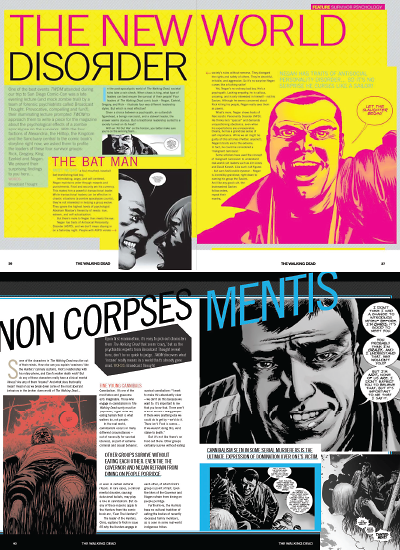Psychiatrists and Pop Culture: A Dynamic Duo
Abstract
Psychiatrists and entertainment consultants Praveen Kambam, M.D., and Vasilis Pozios, M.D., believe that the portrayal of mental illness in the media is improving but still leans heavily on violent connotations.
APA’s 2017 Annual Meeting was held at the San Diego Convention Center, a venue well known to Praveen Kambam, M.D., and Vasilis Pozios, M.D. These young psychiatrists have attended this meeting multiple times, giving presentations at another San Diego conference tradition—Comic-Con.

Praveen Kambam, M.D., Vasilis Pozios, M.D., and Eric Bender, M.D., have channeled their pop-culture know-how and desire to erase the stigma of mental illness into their media consulting group known as Broadcast Thought.
Psychiatrists and comic book enthusiasts might seem like two different crowds, but the nature of Kambam’s and Pozios’ lectures at each conference are remarkably similar, namely, the depiction of mental illness in pop culture.
“We talk often about engaging legislators to enact change, but media and popular culture are also important in shaping people’s perceptions,” said Kambam, an assistant clinical professor of psychiatry and biobehavioral sciences at the David Geffen School of Medicine at the University of California, Los Angeles. Engaging with the media to influence their views and portrayals of mental illness could produce far-reaching effects, he said.
Pozios, a forensic psychiatrist with Corizon Health in Michigan, noted that change is gradually occurring.
“There are more positive depictions of mental illness on television and other media than before,” he said. He cited Claire Danes’s character in “Homeland” and her coping with bipolar disorder as an example of this progress in which psychiatric disorders are traits that shape heroic characters as opposed to being confined to “maniacal” and “psychotic” villains.

As part of his destigmatizing efforts, lifelong comic book fan Vasilis Pozios, M.D., created a comic about a super heroine named Aura who has bipolar disorder.
One significant misrepresentation remains, Pozios said, and that is the perceived relationship between mental illness and violence. “There is very little connection between these two elements, yet the trope that mental illness is tied to violence still persists in media,” he told Psychiatric News. “This might be the last frontier in the effort to erase stigma.”
Shows like “13 Reasons Why,” which explores the suicide of a fictional teen, are now also placing mental health at the thematic forefront, bringing more visibility and depth to delicate topics such as bullying and teenage suicide.
However, Pozios pointed out, “13 Reasons Why” has received fair criticisms about romanticizing or simplifying the nature of suicide.
Experts caution that stark portrayals of mental illness can be risky if not also accompanied by discussions of treatment. For instance, a study in JAMA Internal Medicine found that Internet searches using terms such as “how to commit suicide” and “how to kill yourself” were significantly higher in the days following the March 31, 2017, release of “13 Reasons Why”.
But as they discussed at APA’s Annual Meeting, Kambam and Pozios believe mental health professionals can do more than just warn about misrepresentations—they can use their skills and training to influence positive change.
Kambam and Pozios have firsthand experience in this regard; many years ago at another conference, the two of them, along with fellow APA member Eric Bender, M.D., had wrapped up a presentation on forensic psychiatry and over lunch started chatting about their shared interests in the pop milieu—comics, superheroes, action figures, and the like. That led to the idea of forming a small consulting company to provide mental health expertise to the entertainment industry.
And so Broadcast Thought was born.
Over the years the company has seen many highs, such as its work on the TV series “Bones,” where the company formed more accurate and grounded portrayals of psychosis and of a mental health provider, and being writers for the Official Walking Dead Magazine. There have been lows as well, such as becoming persona non grata at DC Comics after penning a 2011 op-ed that called on the Batman franchise to modernize its portrayals of mental illness and psychiatric hospitals.

Among its numerous collaborations with the media industry, Broadcast Thought contributes regular columns to the Official Walking Dead Magazine.
On the whole, Kambam and Pozios harbor no regrets about their efforts and note that when they discuss Batman and mental health at comic conventions, the reception is much more positive. “Our talks have also revealed that the general audience is fairly sophisticated in their knowledge of mental health, so there is a market for psychiatrists to speak on cultural issues,” Kambam said.
Not everyone can have the opportunity to consult with Hollywood, but Kambam and Pozios said there are many ways to get involved with media in its many forms. Anyone near a good-sized city or working at a university has media outlets nearby, for example. “Put yourself out there and get involved. Let the outlet know you are a subject-matter expert who is willing to comment,” Kambam said.
There are also opportunities to reach the public directly, through op-eds as Broadcast Thought has done, blogs, or even stories. Pozios, for example, is the author of a comic that features the adventures of Aura, a superheroine whose powers are shaped by her bipolar disorder and comorbid migraines (Psychiatric News, May 20, 2016).
After all, being creative and being clinically minded are not mutually exclusive. ■



